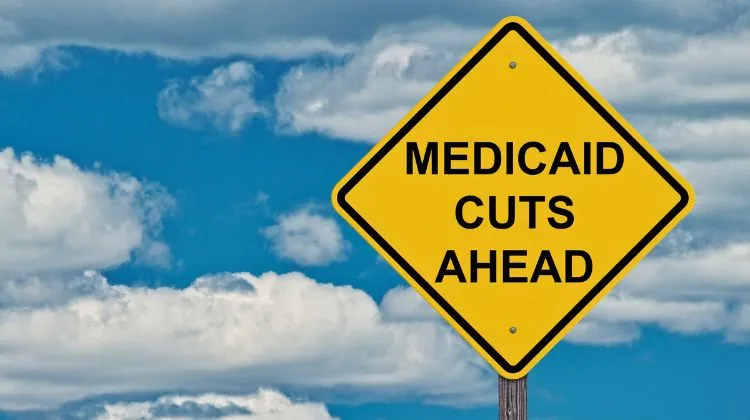
If you rely on Medicaid, or know someone who does, you need to pay attention to what’s happening right now. About one in five people in the U.S. get health coverage through this critical health insurance program. Changes involving Medicaid funding cuts have already started, and more federal policy shifts could be coming soon.
These changes could affect the kind of help you receive and potentially impact Medicaid enrollment. Let’s explore what these Medicaid funding cuts involve and what they might mean for your health care access and overall public health.
Table of Contents:
- What Medicaid Usually Covers
- Beyond Doctor Visits: How Medicaid Got Creative
- Why Fund Things Like Rent or Food? The Health Connection
- Understanding the Recent Medicaid Funding Cuts
- Who Might Be Affected by These Changes?
- It’s Not Just About Waivers: The Bigger Budget Picture
- A Cycle of Change: Historical Context
- State Responses and Potential Variations
- What Can You Do Now?
- Conclusion
What Medicaid Usually Covers
Most people think of Medicaid covering the basics for eligible medicaid enrollees. This includes things like doctor visits, hospital stays, and prescription medicines. Emergency care also falls under this umbrella, forming the foundation of the medicaid program.
These core services are essential for millions across various eligibility groups. For now, these fundamental benefits, crucial for affordable care, seem to be staying in place under current health policy.
But Medicaid has sometimes offered more than just traditional medical care through specific federal funds. That’s where some significant changes are happening now due to shifts in federal spending priorities.
Beyond Doctor Visits: How Medicaid Got Creative
In recent years, the federal government allowed states to try new approaches using Medicaid funds. This happened through something called a Section 1115 waiver. These waivers let states experiment with ways to improve health that weren’t just about treating sickness, often focusing on social determinants of health.
States got permission to use federal medicaid funding for programs called Designated State Health Programs (DSHPs). Sometimes these were known as Designated State Investment Programs (DSIPs). The names aren’t as important as what they did to address factors beyond direct health care.
These programs aimed to address everyday life factors that heavily influence health outcomes. Think about things like stable housing, reliable food sources, and help for caregivers supporting individuals needing long-term care. This approach acknowledged the broad factors affecting public health.
Examples of Innovative Medicaid Uses
Some states got really creative under these waivers, leveraging federal medicaid. The goal was often to prevent health problems before they became serious and costly, impacting total medicaid spending. We saw some inspiring initiatives pop up across the country.
Programs helped pay rent for up to six months in certain situations, preventing homelessness which exacerbates health issues. Some offered transportation help so people wouldn’t miss vital medical appointments or treatments. Others focused on job training or GED assistance, understanding that stable employment significantly impacts individual and community health.
During dangerous heat waves, a few programs even helped people get air conditioners, a critical intervention for vulnerable populations. Support for accessing healthy food or getting supplies like diapers also appeared in some states. Over 20 states used waivers to address housing needs at one point, demonstrating a widespread attempt to connect housing and health through the medicaid program.
Why Fund Things Like Rent or Food? The Health Connection
It might seem strange for a health program like Medicaid to pay for rent or groceries. But there’s a strong, evidence-based link between a person’s living situation and their health status. Poverty and poor health often create a difficult cycle for medicaid enrollees.
Think about it: If you constantly worry about having enough food, your body feels the stress. You might skip meals or buy cheaper, less healthy options, which can worsen conditions like diabetes or heart disease. Addressing food insecurity was seen as a preventative health measure.
Not having a safe place to live can expose you to problems like mold, pests, or extreme temperatures. This can make breathing issues like asthma much worse or lead to other illnesses. The constant stress related to unstable housing raises blood pressure and weakens the immune system, leading to higher health care costs.
If you’ve ever had to decide between paying for medicine and buying food, you understand this difficult reality. If lack of gas money or a reliable ride meant missing a doctor’s visit, you understand the connection between social needs and health care access. Science backs this up, showing how these social factors directly impact physical and mental well-being, contributing to total spending in the healthcare system.
Preventing Crises, Saving Money?
The idea behind funding these supports was straightforward. Helping people with basic needs could prevent bigger health problems and costly interventions down the road. A stable home and enough nutritious food can keep someone healthier, reducing the need for emergency room visits or hospitalizations.
This approach wasn’t just about social assistance; it represented a strategic health policy. It aimed to stop small problems from turning into major health crises that require expensive treatments, potentially reducing total medicaid spending over a year period. In theory, investing early in supports like housing could achieve federal savings and state savings overall.
People were getting help staying in their homes, accessing food, and managing their health better. These programs, funded partly by the federal match, seemed to be making a real difference in many lives, particularly for vulnerable eligibility groups.
Understanding the Recent Medicaid Funding Cuts
Now, the federal agency overseeing Medicaid, the Centers for Medicare & Medicaid Services (CMS), is implementing a policy change. They recently announced a pullback on approving new or renewed funding for these special programs (DSHPs/DSIPs). The federal government is questioning if federal medicaid funding should pay for services not traditionally seen as direct healthcare services.
Federal officials argue these programs might stretch Medicaid’s mission beyond its intended scope. They also raised concerns about program costs, oversight, and whether other government agencies or programs are better suited to handle things like housing aid or food assistance. This involves complex questions about the role of the medicaid program in addressing social determinants of health.
The result is that CMS has decided to stop approving new funding requests for these kinds of waiver programs. They also stated they won’t renew existing DSHP/DSIP funding arrangements when they expire. This funding cut directly impacts states relying on this specific stream of federal funds to support these innovative services.
What Does This Mean for States?
States like California, New York, North Carolina, Oregon, and Washington have used this funding significantly. Now, they face tough choices and potential budget shortfalls. When their current waiver funding for these specific DSHP/DSIP programs runs out, the federal matching dollars disappear, affecting their ability to maintain medicaid services at current levels.
If a state wants to continue offering things like rent assistance or caregiver support through these mechanisms, they’ll likely need to find the money elsewhere, possibly from state tax revenue. Most state budgets are already stretched thin, facing pressures from various directions. This makes continuing these specific initiatives challenging without the federal match rate they previously received.
These Medicaid funding cuts primarily affect the financing mechanism for these supplemental, health-related social services. The core Medicaid benefits like doctor visits and hospital stays are funded differently through the standard federal match process. Those core benefits aren’t the direct target of *this specific* policy change regarding DSHPs, but overall budget pressures remain a concern.
Who Might Be Affected by These Changes?
The impact of this funding cut could ripple out in several ways. Obviously, people directly using services like housing support or food assistance funded by these waivers are at risk of losing that support. If states cannot replace the federal money, those specific programs might shrink, change eligibility, or end entirely, potentially causing individuals to lose coverage for these supports.
But the effects could be broader, impacting various enrollment groups. Some waivers supported improvements to internet access needed for telehealth appointments, particularly in rural areas. Others funded training or enhanced payments for in-home care workers, crucial for long-term care recipients and those in nursing homes.
Even if you don’t use rent help, you might feel the impact if your telehealth options change or if support services for clinics you use are reduced. Many people benefit indirectly from Medicaid-funded services without realizing the source of the funding. Reduced federal medicaid spending in one area can have downstream consequences.
Impact on Vulnerable Groups
Certain groups might feel these changes more acutely. For example, some waiver funds supported infrastructure improvements or community programs involved in addiction treatment and mental health services. With the ongoing opioid crisis, any reduction in support services that help people access and stay in treatment is concerning for public health.
Medicaid plays a huge role in paying for substance use disorder treatment nationwide. While core treatment benefits remain part of medicaid coverage, cuts to supplemental supports funded via these specific DSHP waivers could make accessing comprehensive help harder for some medicaid enrollees. This could undermine progress made in combating addiction.
Caregivers who received support grants or training funded through these waivers might also see changes. People relying on non-medical home care services, often essential for avoiding institutionalization in nursing homes, could face adjustments too. Seniors and people with disabilities who depend on long-term care supports could be particularly affected if states cannot maintain these services.
It’s Not Just About Waivers: The Bigger Budget Picture
These specific Medicaid funding cuts to waiver programs (DSHPs/DSIPs) aren’t happening in isolation. There are larger budget discussions happening in Congress right now that could bring major cuts. Lawmakers are debating the overall federal budget for the upcoming fiscal year, and federal medicaid spending is often a target for reductions aimed at addressing the federal deficit.
Some policy proposals reportedly involve much larger, potentially drastic cuts to the medicaid program overall. These proposed cuts could total hundreds of billions of dollars over a ten-year period. Ideas being discussed in budget resolutions or within the House budget committee include structural changes to how federal medicaid funding is allocated.
These proposals include concepts like imposing a work requirement on certain medicaid enrollees, which critics argue could cause many eligible individuals to lose coverage due to administrative hurdles or temporary life circumstances. Changes to the federal match system, such as implementing a block grant or a per capita cap, are also frequently debated policy proposals. A block grant would give states a fixed amount of federal funding regardless of actual costs or enrollment increases, while a per capita cap would set federal funding per enrollee, potentially not keeping pace with rising health care costs.
Such changes would fundamentally alter the financial partnership between the federal government and states, potentially shifting significant costs and risks to states and reducing federal spending. There has even been talk about lifetime limits on benefits, though details remain unclear. If major cuts pass Congress, perhaps driven by desires for tax cuts elsewhere, states would face even more intense pressure and extremely tough choices. They might need to make deeper cuts to eligibility, benefits, or provider payments, raise taxes significantly, or change eligibility rules just to maintain medicaid programs, potentially impacting the expansion population covered under the Affordable Care Act and other eligibility groups.
A Cycle of Change: Historical Context
It’s worth remembering that policies around these Medicaid waivers and federal funding have shifted before. The use of Section 1115 waivers to fund health-related social needs expanded significantly in recent years, often encouraged by specific federal policy goals. But this isn’t the first time the focus of federal medicaid policy has changed.
During the Trump administration, for example, there was a different emphasis, including encouragement of waivers incorporating things like a work requirement. Then, under the Biden administration, approvals for waivers addressing social determinants of health increased again, leading to many of the DSHP/DSIP programs now facing funding withdrawal. This reflects differing philosophies on the scope and flexibility of the medicaid program.
So, we’re seeing another shift in federal policy now. This doesn’t automatically mean innovative programs addressing social needs are gone forever. Future administrations or new policy proposals could potentially bring them back or create new mechanisms for funding, possibly with different requirements or using a different federal match rate structure.
This history provides some perspective on the dynamic nature of health policy. But it doesn’t diminish the real concerns for people who depend on these supports right now or the challenges states face in adapting to reduced federal medicaid funding for these specific initiatives. The stability of health insurance for millions hangs in the balance during these periods of change.
State Responses and Potential Variations
How states react to these federal funding cuts will likely vary based on several factors. State fiscal health, political leadership, existing commitments, and the perceived success of the DSHP/DSIP programs will all play a role. Some states might look for alternative funding sources, perhaps involving partnerships with foundations or reallocating state tax revenues.
Other states might decide they cannot afford to continue these programs without the enhanced federal match or standard federal funds previously provided. This could lead to program reductions or eliminations. It’s unlikely that any potential state-level cuts would be applied evenly across all services or enrollment groups; choices will need to be made about priorities.
States might also explore efficiencies within their existing medicaid program or look towards negotiating lower provider payments, although this can impact access to care. Some might consider seeking different types of waivers or state plan amendments to continue certain activities, though CMS approval would still be required. The impact on local governments, which often partner in delivering these services, could also be significant.
Policy analysis from various research groups often provides detailed breakdowns, sometimes in an appendix table format, showing how proposed cuts might be allocated proportionately or disproportionately across different populations. Monitoring state legislative sessions and budget debates will be crucial for understanding specific local impacts. These are the tough choices facing state policymakers trying to maintain medicaid coverage and services.
What Can You Do Now?
Hearing about potential Medicaid funding cuts can be worrying, but try not to panic. These changes, specifically regarding the DSHP/DSIP funding mechanism, will likely happen over time as current state agreements expire, not all at once across the board. Keeping yourself informed about what’s happening with federal medicaid and your state’s specific plans is the first step.
If you currently receive Medicaid or use services you think might be affected by these federal cuts, connect with your state’s Medicaid office. They are the best source for official information about specific programs in your area and any planned changes impacting medicaid coverage or eligibility groups. You can usually find contact information easily on your state government’s website; pay attention to their privacy policy regarding any information you submit online and ensure your browsing experience is secure.
Consider learning about other local resources that might offer help with food, housing, utilities, or transportation if you’re concerned about losing support currently funded through Medicaid waivers. Community action agencies, local non-profits, food banks, or 2-1-1 helplines sometimes offer assistance. Knowing all available options is always a good strategy, especially during times of potential policy change.
Sharing your experiences can also be powerful. If Medicaid programs, including those supporting social needs, have helped you or your family, talking about it helps policymakers and the public understand their value. Public awareness and personal stories can sometimes influence health policy discussions and state-level decisions about whether to raise taxes or cut programs.
Conclusion
The landscape of Medicaid is currently shifting, particularly concerning how states can use federal funds for health-related social needs. Recent federal decisions mean significant Medicaid funding cuts for specific waiver programs (DSHPs/DSIPs) that supported things like housing and food aid in several states. While core medical benefits covered by the medicaid program aren’t directly targeted by this specific policy change, the loss of federal funding for supplemental supports could impact many individuals, families, and the expansion population.
States now face difficult choices about whether and how to continue these programs without the expected federal match, potentially requiring shifts in tax revenue or cuts elsewhere. This situation is unfolding alongside broader budget debates in Congress that could lead to even more substantial changes to total medicaid spending later on, possibly through mechanisms like a block grant, per capita cap, or the introduction of a work requirement. Understanding these ongoing potential medicaid cuts and staying informed through official state channels is important for everyone who relies on this vital health insurance program for their health care needs, including long-term care.
The coming months and the next fiscal year will likely bring more clarity on the full impact of these federal cuts and any additional policy proposals affecting federal medicaid funding. Staying engaged and informed is crucial for navigating these changes.




Leave a Reply